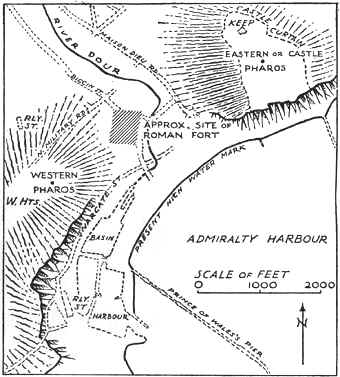|
Elizabethan dream, in which Julius Caesar and
Arviragus characteristically figure.78
A second pharos seems to have stood opposite to the
one just described, three-quarters of a mile away, on a spot now
covered by the Drop Redoubt.79 To the earlier
antiquaries this pharos was better known than its neighbour on
the Castle Hill. Indeed, Leland, Lambarde and Camden mention the
former and ignore the latter. Old views of Dover show that as
late as the end of the seventeenth century this tower stood high
above ground, a prominent mark on the bare Western Heights. |
|

FIG. 11 SKETCH MAP OF DOVER, SHOWING THE
SITES OF THE CASTLE PHAROS, THE WESTERN PHAROS, AND
APPROXIMATELY THE ROMAN FORT (Reproduced from Arch.Journ.
lxxxvi, 30)
|
The Canterbury antiquary, Thomas
Twyne, told Camden that in his youth he had seen it nearly
perfect, and that it was a pharos. He was probably right. It
must at least have served as a seamark; and it is but a slight
step further to imagine that Roman Dover was flanked by twin
lights which would serve not merely to ‘bracket’ the harbour
but would form a distinctive feature amongst the coastwise
signals. By the first half of the eighteenth century the western
tower had fallen into an advanced state of decay. It was then
known alternatively as the Bredenstone or the Devil’s Drop,
and here, from the middle of the seventeenth century onwards,
the |
|
Lords Warden of the Cinque Ports were sworn
in. After further vicissitudes the foundation of it was buried,
in 1861, in the present redoubt, in which a small and formless
fragment of it is still
78 For the pharos
see Leland, vii, 128; Stukeley, Itim. (ed. i), p. 121,
the first attempt at a real survey; Wheeler, Arch. Journ. lxxxvi,
29, a full account. On ancient phari generally, see H. Thiersch,
Pharos (Leipzig, Teubner, 1909). For the church—often,
but absurdly, ascribed to the Roman period—see Gilbert Scott, Arch.
Cant. v, 1—18; Micklethwaite, Arch. Journ. liii,
327; Baldwin Brown, Arts in Early England, ii, 292, 308.
Canon Puckle’s Church and Fortress of Dover Castle (Oxford,
1864) contains useful details, but is written with little
knowledge of Roman history or archaeology. The author thinks
that British Christians built the church about the end of the
Diocletian persecution, ‘when their weakened masters were on
the point of abandoning the colony.’ This ignores the 100
years which intervened between Diocletian and the withdrawal of
the Romans from Britain; and it also mistakes the relations of
Romans and Britons at the time. Cf. Peck in Brit. Arch.
Assoc. N.S. xx, 24B; and Haverfield in Brit. Acad. Suppl.
Papers, ii, 1914, p. 3.
79 For a
full account of the history of this ‘ pharos’ since the
sixteenth century, see Wheeler, Arch. Journ. lxxxvi, 40. |